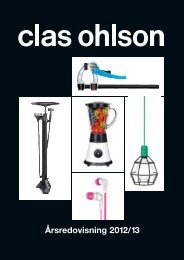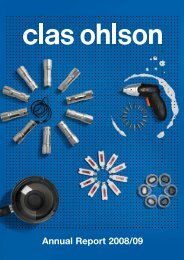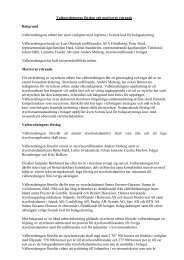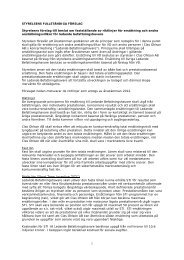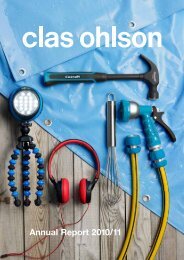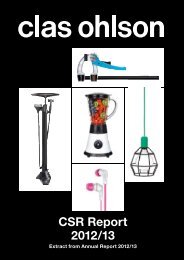Annual Report 2012/13 - Clas Ohlson
Annual Report 2012/13 - Clas Ohlson
Annual Report 2012/13 - Clas Ohlson
Create successful ePaper yourself
Turn your PDF publications into a flip-book with our unique Google optimized e-Paper software.
and expenses directly attributable to the asset in order to bring it into the<br />
position and condition necessary for it to be utilised in accordance with the<br />
purpose of the acquisition. Depreciation/amortisation is based on the cost<br />
and estimated useful life of the assets. Straight-line depreciation/amortisation<br />
is used for all assets. Land is not depreciated. The Group applies component<br />
depreciation, which means that depreciation is based upon the estimated<br />
useful life of the components. The following depreciation periods are applied:<br />
Intangible assets<br />
Equipment. tools. fixtures and fittings<br />
Buildings <br />
Land improvements <br />
5–7 years<br />
5–15 years<br />
20–33 years<br />
20 years<br />
New acquisitions and replacements are capitalised, while maintenance and<br />
repair costs are expensed. As assets are sold or disposed of, the cost and<br />
appurtenant accumulated depreciation are written off. Any profit or loss is<br />
recognised. All of <strong>Clas</strong> <strong>Ohlson</strong>’s properties are owner-occupied properties.<br />
Impairment<br />
Depreciable assets are assessed to determine any decrease in value resulting<br />
from events or changes in circumstances indicating that the carrying amount<br />
might not be recoverable. An impairment loss is recognised in the amount<br />
by which the carrying amount of the asset exceeds its recoverable value.<br />
The recoverable value is the higher of the fair value of the asset less selling<br />
expenses and value in use. In assessing impairment loss, assets are grouped<br />
at the lowest levels at which there are separate identifiable cash flows (cashgenerating<br />
units).<br />
Capitalised IT and software costs<br />
Costs for the maintenance of software are expensed when they arise.<br />
Development costs directly attributable to the development and testing<br />
of identifiable and unique software products controlled by the Group are<br />
recognised as intangible assets when the following criteria have been fulfilled:<br />
• It is technically possible to complete the software so that it can be used,<br />
• The company’s intention is to complete the software and use or sell it,<br />
• The conditions for using the software exist,<br />
• How the software generates probable financial advantages can be<br />
proven,<br />
• Adequate technological. financial and other resources for completing the<br />
development and for using or selling the software are available, and<br />
• The costs attributable to the software over the course of its development<br />
can be reliably calculated.<br />
Directly attributable costs are capitalised as a portion of the software and<br />
include costs for employees and a reasonable share of indirect costs.<br />
Other development costs, which do not meet these criteria, are expensed<br />
when they arise. Development costs that were previously expensed are<br />
not recognised as an asset in subsequent periods. Development costs<br />
for software recognised as an asset are amortised during the software’s<br />
estimated useful life.<br />
Leasing<br />
In the Group and in the Parent Company, lease contracts occur primarily in<br />
the form of rental contracts for retail premises. All the stores, except the one<br />
in Insjön, are leased. These contracts have been classified as operational<br />
leases as they do not signify that the economic benefits and risks associated<br />
with ownership have been transferred to the tenant.<br />
Operational leases, in which the Group is the lessee, are recognised in<br />
consolidated profit and loss as an operating expense straight line over the<br />
leasing period. In cases in which the Group is the lessor, the revenue is<br />
recognised as a sale in the period to which the leasing pertains. Depreciation<br />
is recognised in operating income.<br />
Loan expenses<br />
Loan expenses attributable to the forming of what is known as qualified<br />
assets are capitalised where appropriate as part of the qualified asset’s cost.<br />
A qualified asset is an asset that as a necessity takes a significant amount of<br />
time to complete. There are currently no qualified assets.<br />
Other loan expenses are charged against earnings during the period in<br />
which they arose.<br />
Inventories<br />
Inventories have been valued at the lower of cost and net selling price on the<br />
balance-sheet date, applying the “first in, first out” principle. Net selling price<br />
is the estimated selling price in operating activities less selling expenses.<br />
Inter-company profits arising from delivery between companies forming<br />
part of the Group are deducted. Necessary provision for obsolescence has<br />
been made. Inventory expenses include transfers from other comprehensive<br />
income of any gains/losses from cash flow hedging fulfilling the conditions for<br />
hedge accounting, attributable to purchases of goods.<br />
Receivables<br />
Receivables with a due date more than 12 months after the balance-sheet<br />
date are recognised as non-current assets, while others are regarded as<br />
current assets. Receivables are recognised at the amount expected to be<br />
paid after individual testing.<br />
Accounts receivable are recognised initially at fair value and then at<br />
amortised cost applying the effective interest rate method, less any provision<br />
for depreciation. A provision for depreciation is posted when there is objective<br />
evidence that the Group will not be able to receive all sums due according<br />
to the original terms of the receivables. The amount of the provision is<br />
recognised in profit or loss.<br />
Financial instruments<br />
Purchases and sales of financial instruments are recognised on the trade<br />
date – the date when the Group binds itself to purchase or sell the asset.<br />
Financial instruments are initially measured at fair value plus transaction<br />
expenses, which applies to all financial assets not measured at fair value<br />
through profit or loss. If the market for a financial asset is not active (and<br />
for unlisted securities), the Group will establish the fair value by applying<br />
such valuation methods as the use of information concerning recently<br />
completed transactions on an arms-length basis, reference to the fair value<br />
of another instrument that is essentially equivalent, analyses of discounted<br />
cash flow and options valuation methods. In this connection, market information<br />
is widely used while company-specific information is used as little<br />
as possible. Financial instruments are derecognised from the balance sheet<br />
when the right to receive cash flows from the instrument has expired or been<br />
transferred and the Group has transferred virtually all the risks and benefits<br />
associated with right of ownership.<br />
Loan receivables and accounts receivable<br />
Loan receivables and accounts receivable are recognised at amortised cost<br />
with application of the effective interest method.<br />
Cash-flow hedging<br />
The effective portion of changes in the fair value for a derivative instrument<br />
identified as the cash-flow hedge portion and which meets the conditions for<br />
hedge accounting is recognised in other comprehensive income. The gain<br />
or loss attributable to the ineffective portion is recognised immediately in the<br />
income statement among the items operating income and other operating<br />
expenses – in net form.<br />
Hedging of net investments<br />
The hedging of net investments in foreign operations is recognised in a similar<br />
manner as in the case of cash-flow hedging.<br />
The portion of gain or loss attributable to a hedging instrument viewed as<br />
an effective hedge is recognised in other comprehensive income. The gain<br />
or loss attributable to the ineffective portion is recognised in the income statement.<br />
Accumulated gains and losses in equity are recognised in the income statement<br />
when non-Swedish operations are partly or totally divested.<br />
Cash and cash equivalents<br />
Cash and cash equivalents consist of cash and immediately available<br />
balances at banks and equivalent institutions, as well as short-term<br />
investments with a term of less than three months from the time of acquisition.<br />
Employee benefits<br />
Both defined-benefit and defined-contribution pension plans exist. There<br />
are both defined-contribution and defined-benefit pension plans in the<br />
Parent Company. However, in accordance with statement UFR 3, the<br />
defined-benefit ITP pension plan (Alecta) is treated as a defined-contribution<br />
pension policy. Defined-benefit pension plans are available in the Norwegian<br />
subsidiary. Future obligations with regard to defined-benefit pension plans<br />
are calculated annually according to a method described in detail below.<br />
In defined-contribution plans, the company pays set contributions to a<br />
separate legal entity and is not obligated to pay any further contributions.<br />
Expenses are charged against Group profits as the benefits are vested.<br />
Accounts 65




